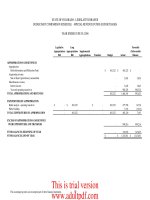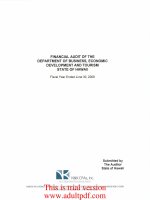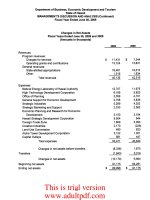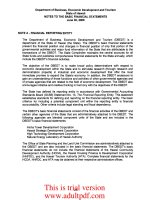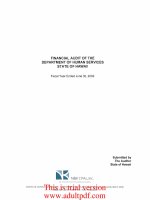LEGISLATIVE DEPARTMENT, STATE OF COLORADO FINANCIAL AUDIT REPORT YEAR ENDED JUNE 30, 2005 AND 2004_part3 pdf
Bạn đang xem bản rút gọn của tài liệu. Xem và tải ngay bản đầy đủ của tài liệu tại đây (50.29 KB, 11 trang )
STATE OF COLORADO - LEGISLATIVE BRANCH
BUDGETARY COMPARISON SCHEDULE - SPECIAL REVENUE FUNDS (BUDGET BASIS)
YEAR ENDED JUNE 30, 2004
Legislative Long Favorable
Appropriations Appropriations Supplemental (Unfavorable)
Bill Bill Appropriations Transfers Budget Actual Balance
APPROPRIATIONS AND REVENUES
Appropriation
Ballot Information and Publication Fund
492,322$ 492,322$ -$
Augmenting revenue
Sale of State Capitol history memorabilia
- 3,854 3,854
Miscellaneous revenue
Interest income
- 3,845 3,845
Year-end operating transfers in
- 984,324 984,324
TOTAL APPROPRIATIONS AND REVENUES
492,322 1,484,345 992,023
EXPENDITURES BY APPROPRIATION
Ballot analysis - operating transfer in
-$ 492,322$ -$ 492,322 477,596 14,726
Public building
- - - - - 7,533 (7,533)
TOTAL EXPENDITURES BY APPROPRIATION
- 492,322 - - 492,322 485,129 7,193
EXCESS OF APPROPRIATIONS AND REVENUE
OVER EXPENDITURES AND TRANSFERS
- 999,216 999,216
FUND BALANCES, BEGINNING OF YEAR
- 747,835 747,835
FUND BALANCES, END OF YEA
R
-$ 1,747,051$ 1,747,051$
The accompanying notes are an integral part of these financial statements.
19
This is trial version
www.adultpdf.com
LEGISLATIVE DEPARTMENT, STATE OF COLORADO
NOTES TO FINANCIAL STATEMENTS
YEARS ENDED JUNE 30, 2005 AND 2004
20
NOTE 1 - DEFINITION OF REPORTING ENTITY:
The Legislative Department (or, the “Department”) is a sub-entity of the State of Colorado. The State of Colorado
is the oversight entity that has the responsibility for primary reporting of the State's financial activities. The
accompanying financial statements present only that portion of the State of Colorado's financial position and
activity which pertains to the Legislative Department. The Department's primary activities are included in the
General Fund of the State of Colorado basic financial statements. The Department consists of six agencies:
General Assembly, Joint Budget Committee, Legislative Council, Office of the State Auditor, Office of
Legislative Legal Services, and Reapportionment Commission, when active.
The Department follows the Governmental Accounting Standards Board (GASB) accounting pronouncements
which provide guidance for determining which governmental activities, organizations, and functions should be
included within the financial reporting entity. GASB pronouncements set forth the financial accountability of a
governmental organization's elected body as the basic criterion for including a possible component governmental
organization in a primary government's legal entity. Financial accountability includes, but is not limited to,
appointment of a voting majority of the organization's governing body, ability to impose its will on the
organization, a potential for the organization to provide specific financial benefits or burdens, and fiscal
dependency.
The Department is not financially accountable for any other organization.
NOTE 2 - SUMMARY OF SIGNIFICANT ACCOUNTING POLICIES:
The more significant accounting policies of the Legislative Department are described as follows:
A. Measurement Focus, Basis of Accounting, and Financial Statement Presentation:
The Legislative Department, in conjunction with the State of Colorado, adopted Governmental Accounting
Standards Board (“GASB”) Statement No. 34, Basic Financial Statements – and Management’s Discussion and
Analysis – for State and Local Governments, effective July 1, 2001. GASB Statement No. 34 specifically requires
that general purpose governments prepare government wide financial statements. The Legislative Department
does not meet the definition of a general purpose government and, therefore, presents its financial statements on a
fund basis. The Legislative Department is a sub-entity of the State of Colorado; therefore, its financial activities
are presented within the State of Colorado’s Comprehensive Annual Financial Report.
Fund financial statements are reported using the current financial resources measurement focus and the modified
accrual basis of accounting. Revenues are recognized as soon as they are both measurable and available.
Revenues are considered to be available when they are collectible within the current period or soon enough
thereafter to pay liabilities of the current period. Expenditures are recorded when a liability is incurred, as under
accrual accounting. However, expenditures related to compensated absences are recorded only when payment is
due and payable.
This is trial version
www.adultpdf.com
LEGISLATIVE DEPARTMENT, STATE OF COLORADO
NOTES TO FINANCIAL STATEMENTS (CONTINUED)
YEARS ENDED JUNE 30, 2005 AND 2004
21
NOTE 2 - SUMMARY OF SIGNIFICANT ACCOUNTING POLICIES (CONTINUED):
A. Measurement Focus, Basis of Accounting, and Financial Statement Presentation (continued):
The financial activities of the Department are recorded in individual funds, each of which is deemed to be a
separate accounting entity. The Department uses fund accounting to report on its financial position and results of
operations. Fund accounting is designed to demonstrate legal compliance and to aid financial management by
segregating transactions related to certain government functions or activities. A fund is a separate accounting
entity with a self-balancing set of accounts.
The Legislative Department reports the following two governmental fund types:
The General Fund is the principal operating fund of the Department. It accounts for all financial
resources except those required to be accounted for in another fund.
Special Revenue Funds include fund activities financed by specific revenue sources that are legally
restricted for specified purposes.
The Department has the following three special revenue funds:
The Ballot Information Publication and Distribution Revolving Fund was created by Senate Bill 97-
204 to pay the costs of publishing the text and title of each constitutional amendment and initiated or
referred measure in every legal newspaper in the State as required by Section 1-40-124, C.R.S., and to
pay the costs of distributing the ballot information booklet as required by subsection (2) of Section 1-40-
124.5, C.R.S. Any monies credited to the revolving fund and unexpended at the end of any given fiscal
year will remain in the fund. Monies in the revolving fund are continuously appropriated.
The Public Buildings Trust Fund was created for the purpose of promoting historical interest in the
State Capitol Building. Receipts from gifts, grants, or donations and sales to the public of publications on
the history of the State Capitol Building and other State Capitol memorabilia and associated
disbursements are accounted for in this fund. Transactions recorded in this fund on these financial
statements reflect only the activity of this special account of the Legislative Department.
The Legislative Legal Expenses Cash Fund was created by House Bill 04-1369 to pay the
compensation and expenses of any legal counsel retained by the Committee on Legal Services pursuant to
Section 2-3-1001, C.R.S., and to pay any necessary expense of such actions and proceedings for which
such legal counsel is retained. Senate Bill 05-157 amended the statute to provide for payment of other
qualified expenses from the fund. The Executive Committee of the Legislative Council may authorize
payment of expenses relating to legislative aides and expenses relating to the upkeep and furnishings of
space occupied by the Legislative Branch, if the amount of monies to be so expended is not needed in the
foreseeable future for compensation and expenses of legal counsel. Monies in the fund are continuously
appropriated.
This is trial version
www.adultpdf.com
LEGISLATIVE DEPARTMENT, STATE OF COLORADO
NOTES TO FINANCIAL STATEMENTS (CONTINUED)
YEARS ENDED JUNE 30, 2005 AND 2004
22
NOTE 2 - SUMMARY OF SIGNIFICANT ACCOUNTING POLICIES (CONTINUED):
B. Budgets:
Expenditures of the Department are authorized under annual appropriations and supplemental appropriations
made by the State General Assembly. The legislative appropriation is constitutionally limited to the unrestricted
funds held by the State at the beginning of the year as determined by the modified accrual basis of accounting.
Expenditures are controlled through the use of encumbrances. Monies are reserved for satisfaction of obligations
incurred under contracts and purchase orders. Encumbrances outstanding at year-end are not reported as a
reservation of fund balance, but rather become a commitment against resources that will become available in
future periods.
The State Controller has the authority to approve the carryover of unexpended appropriations to the subsequent
fiscal year under circumstances described in the State Fiscal Rules.
The budget for all funds is adopted on a basis consistent with United States Generally Accepted Accounting
Principles (GAAP) except as follows:
• Expenditures for budgetary purposes exclude amounts for salaries and benefits incurred but unpaid at year
end.
• Expenditures for budgetary purposes exclude amounts for capital assets acquired under a capital lease.
• Payments from the General Fund to the Ballot Information Publication and Distribution Revolving Fund and
the Legislative Legal Expenses Cash Fund are treated as expenditures for budgetary purposes and as operating
transfers for GAAP purposes.
Budget to GAAP differences for General Fund expenditures for the fiscal years ending June 30, 2005 and 2004
are as follows:
2005
2004
Total expenditures, GAAP basis $ 26,841,539 $ 26,713,415
Reduction (increase) in salaries incurred but
unpaid (35,376)
72,576
Transfers to Ballot Revolving Fund and
Legislative Legal Expenses Cash Fund 492,322
1,476,646
Total expenditures, Budgetary basis $ 27,298,485
$ 28,262,637
This is trial version
www.adultpdf.com
LEGISLATIVE DEPARTMENT, STATE OF COLORADO
NOTES TO FINANCIAL STATEMENTS (CONTINUED)
YEARS ENDED JUNE 30, 2005 AND 2004
23
NOTE 2 - SUMMARY OF SIGNIFICANT ACCOUNTING POLICIES (CONTINUED):
C. Cash:
The balance in cash at June 30, 2005 and 2004 represents the net year-end effect of transactions between the
Legislative Department and the State's General Fund. The balance can be positive, in which case it represents a
claim against the unrestricted fund balance of the State General Fund, or negative, in which case it represents the
amount to be provided by the Legislative Department appropriations to the unrestricted fund balance of the State
General Fund.
The Department deposits cash with the Colorado State Treasurer as required by Colorado Revised Statutes (CRS).
The State Treasurer pools these deposits and invests them in securities approved by Section 24-75-601.1, C.R.S.
The Department reports its share of the Treasurer's unrealized gains/losses on the basis of its participation in the
State Treasurer's pool. All of the Treasurer's investments are reported at fair value, which is determined on the
basis of quoted market prices at June 30, 2005 and 2004. The State Treasurer does not invest any of the pool in
any external investment pool, and there is no assignment of income related to participation in the pool. The
unrealized gains and losses included in "Interest Income" reflect only the change in fair value during the current
fiscal year. Additional information on the Treasurer's pool may be obtained in the State of Colorado's
Comprehensive Annual Financial Report, available from the State Controller’s Office.
D. Capital Assets:
Capital assets are stated at cost, except for those assets contributed, which are stated at the estimated fair market
value at the date of contribution. Capital assets are recorded as expenditures in the year of acquisition.
E. Compensated Absences:
The Department has a policy that allows employees to accumulate unused vacation benefits and sick leave up to
certain maximums. Compensated absences are recognized as current salary costs only when paid. As such, none
of the accrued vacation or sick leave benefits would normally be liquidated with expendable available financial
resources.
F. Fund Balance:
In the fund financial statements, a portion of the fund balance has been reserved for amounts that are legally
segregated or are not subject to future appropriation. The reserved fund balance in the Ballot Information
Publication and Distribution Revolving Fund is to be used exclusively for the printing and distribution of annual
ballot information. The fund balance in the Ballot Information Publication and Distribution Fund was $826,350 at
June 30, 2005 and $1,253,152 at June 30, 2004. The reserved fund balance in the Public Buildings Trust Fund is
to be used exclusively for the promotion of history publications and memorabilia related to the Capitol Building.
The fund balance in the Public Buildings Trust Fund was $5,154 at June 30, 2005 and $9,575 at June 30, 2004.
The reserved fund balance in the Legislative Legal Expenses Cash Fund is to be used exclusively for the legal
expenses of the Legislative Branch, expenses relating to legislative aides, and expenses relating to the upkeep and
furnishings of space occupied by the Legislative Branch. The fund balance in the Legislative Legal Expenses
Cash Fund was $497,915 at June 30, 2005 and $484,324 at June 30, 2004.
This is trial version
www.adultpdf.com
LEGISLATIVE DEPARTMENT, STATE OF COLORADO
NOTES TO FINANCIAL STATEMENTS (CONTINUED)
YEARS ENDED JUNE 30, 2005 AND 2004
24
NOTE 2 - SUMMARY OF SIGNIFICANT ACCOUNTING POLICIES (CONTINUED):
F. Fund Balance (continued):
At June 30, 2005 and 2004, the General Fund had unreserved deficit fund balances of $1,464,883 and $1,429,507,
respectively. These negative fund balances are due to salaries and benefits being incurred but unpaid at fiscal year
end as discussed in Note 3. The Department received the appropriation to pay those salaries and benefits on July
1 of the following year.
NOTE 3 - ACCRUED SALARIES AND BENEFITS:
Senate Bill 03-197 requires employee salaries to be paid on a monthly basis as of the last working day of the
month, except that salaries for the month of June shall be paid on the first working day of July. The salaries and
benefits earned, but unpaid, as of June 30, 2005 and 2004 were $1,479,164 and $1,445,038, respectively.
Accordingly, the accrued compensation is reflected as a liability in the accompanying financial statements.
NOTE 4 - APPROPRIATIONS AND REVENUE:
The Legislative Department’s primary funding source consists of an appropriation from the State’s General Fund.
This appropriation is supplemented by appropriations from cash funds and cash exempt funds. The cash funds
appropriated to the Department are from sales of publications. Cash exempt funds are transfers from other
agencies within the State. These funds are designated as “exempt” because they are exempt from the Taxpayer’s
Bill of Rights (TABOR) calculations discussed in Note 7. The unspent appropriations are either rolled forward to
the next fiscal year with the approval of the State Controller’s Office or reverted to the State’s General Fund.
The Legislative Department appropriation specified that $90,000 of revenue earned by the sale of bill copies was
available for expenditure by the General Assembly. Receipts for sales in excess of that amount each year, as well
as receipts for sales of Colorado Revised Statutes and supplements, were not available for expenditure by the
Department. The Legislative Department appropriation also specified that $637,701 of audit revenue was
available for expenditure by the Office of the State Auditor. Receipts in excess of that amount were not available
for expenditure.
Miscellaneous revenue consists of charges in excess of $637,701 for audit services performed by the Office of the
State Auditor for certain non state-appropriated activities of the State, the sale of bill copies in excess of $90,000,
and other miscellaneous amounts.
This is trial version
www.adultpdf.com
LEGISLATIVE DEPARTMENT, STATE OF COLORADO
NOTES TO FINANCIAL STATEMENTS (CONTINUED)
YEARS ENDED JUNE 30, 2005 AND 2004
25
NOTE 5 - AUDIT CONTRACTS:
The Office of the State Auditor contracts with private firms to perform audits of various state agencies and
authorities. In situations where the state agency or authority is required by law to pay for audit costs, the Office of
the State Auditor acts as agent and offsets the amounts paid to the private firms by the amounts reimbursed by the
auditee agency or authority. The reimbursement for Fiscal Year 2005 was $1,341,000 and for Fiscal Year 2004
was $834,174. These amounts are not reflected in audit reimbursement revenue.
As of June 30, 2005 and 2004, the Office of the State Auditor had contract commitments of $650,610 and
$719,787, respectively, with independent certified accountants (and/or non-accounting firms) to perform audit and
consulting services.
NOTE 6 - TAX, SPENDING, AND DEBT LIMITATIONS:
In November 1992 the voters of Colorado approved Amendment 1, commonly known as the Taxpayer's Bill of
Rights (TABOR), which adds a new Section 20 to Article X of the Colorado Constitution. TABOR contains tax,
spending, revenue, and debt limitations.
The Department's financial activity, as part of the State of Colorado's budget for Fiscal Year 1993, provided the
basis for calculation of future limitations at the state level adjusted for allowable increases tied to inflation and
population. Subsequent to 1993, revenue in excess of the State's "spending limit" must be refunded unless voters
approve the retainage of such excess revenue. TABOR generally requires voter approval for any new tax, tax
increases, and new debt.
TABOR does not affect the Department's Fiscal Year 2005 and 2004 financial statements; however, the
limitations contained in TABOR may impact future financial activity of the State of Colorado and the Department.
NOTE 7 - RELATED PARTY TRANSACTIONS:
The Department is a branch of Colorado State Government, and as such, receives many services from other state
agencies, many of which are not billed to the Department. The most significant of these are accounting support
and review services provided by the State Controller's Office.
This is trial version
www.adultpdf.com
LEGISLATIVE DEPARTMENT, STATE OF COLORADO
NOTES TO FINANCIAL STATEMENTS (CONTINUED)
YEARS ENDED JUNE 30, 2005 AND 2004
26
NOTE 8 - OPERATING LEASES:
The Department had several operating leases for equipment and paid rent for the capitol complex building space
used by Legislative Department service agencies. Total operating lease (rent) expense for fiscal years 2005 and
2004 was $1,439,528 and $1,234,797, respectively. Future minimum commitments for the capitol complex lease
do not exceed one year. Operating leases for equipment expire November 2005 through January 2009, and the
future minimum annual rental commitments are as follows:
Minimum
Years ending June 30
, lease payments
2006 $ 230,623
2007 179,820
2008 120,265
2009 5,977
$ 536,685
NOTE 9 - CAPITAL ASSETS:
Pursuant to the provisions of GASB Statement No. 34, the Department’s fixed assets are reported only in the
statewide financial statements. In addition, these fixed assets are depreciated over their estimated useful lives, but
depreciation expense is also reported only in the statewide financial statements.
Fixed assets are stated at historical cost. Donated fixed assets are stated at their estimated fair value on the date
donated. The capitalization criterion for fixed assets is $5,000 for furniture, equipment, and software. Fixed
assets are depreciated using the straight-line method over the estimated useful lives of the related assets, which
range from 3 years to 39 years.
This is trial version
www.adultpdf.com
LEGISLATIVE DEPARTMENT, STATE OF COLORADO
NOTES TO FINANCIAL STATEMENTS (CONTINUED)
YEARS ENDED JUNE 30, 2005 AND 2004
27
NOTE 9 - CAPITAL ASSETS (CONTINUED):
The following is a summary of changes in the Department’s fixed assets to be included with governmental
activities in the statewide financial statements:
Equipment
Software
Total
Cost
Balances, July 1, 2003 $ 1,029,362 $ - $ 1,029,362
Additions 104,175 - 104,175
Balances, July 1, 2004 1,133,537 - 1,133,537
Additions 132,101 83,000 215,101
Balances, June 30, 2005 1,265,638 83,000
1,348,638
Accumulated depreciation
Balances, July 1, 2003 (618,694) - (618,694)
Additions (120,360) - (120,360)
Balances July 1, 2004 (739,054) - (739,054)
Additions (127,712) (8,300) (136,012)
Balances, June 30, 2005 (866,766) (8,300) (875,066)
Total fixed assets, net $ 398,872 $
74,700 $
473,572
This is trial version
www.adultpdf.com
LEGISLATIVE DEPARTMENT, STATE OF COLORADO
NOTES TO FINANCIAL STATEMENTS (CONTINUED)
YEARS ENDED JUNE 30, 2005 AND 2004
28
NOTE 10 - LONG-TERM OBLIGATIONS:
Long-term liability activity for the fiscal years ended June 30, 2005 and 2004 included capital leases and
compensated absences and were as follows:
Capital lease
Compensated
absences
Total
Balances, July 1, 2003 $ 38,856 $ 1,743,451 $ 1,782,307
Additions - 6,693 6,693
Reductions (6,934) (241,192) (248,126)
Balances, July 1, 2004 31,922 1,508,952 1,540,874
Additions - 98,146 98,146
Reductions (7,547) (123,876) (131,423)
Balances, June 30, 2005 $ 24,375 $ 1,483,222 $
1,507,597
Due within one year $ 8,214 $ 61,339 $ 69,553
In April, 2003, the Department entered into a capital lease agreement to finance the acquisition of an AB Dick
9975 PFA Press #6983 for $40,500. The capital lease has an effective interest rate of 8.5 percent and is
collateralized by the leased equipment. The lease expires in March 2008. The future annual lease payments
required for this capital lease are as follows:
Year ending
June 30,
Interest Principal
Total
payments
2006 $ 1,757 $ 8,214 $ 9,971
2007 1,030 8,941 9,971
2008 258 7,220 7,478
$ 3,045 $ 24,375 $ 27,420
This is trial version
www.adultpdf.com
LEGISLATIVE DEPARTMENT, STATE OF COLORADO
NOTES TO FINANCIAL STATEMENTS (CONTINUED)
YEARS ENDED JUNE 30, 2005 AND 2004
29
NOTE 11 – PENSION PLANS:
A. Plan Description:
The majority of the Department’s employees participate in a defined benefit pension plan. The plan's purpose is
to provide income to members and their families at retirement or in case of death or disability. The plan is a cost
sharing multiple employer plan administered by the Public Employees’ Retirement Association (PERA). PERA
was established by state statute in 1931. Responsibility for the organization and administration of the plan is
placed with the Board of Trustees of PERA. Changes to the plan require legislation by the General Assembly.
The state plan and other divisions’ plans are included in PERA’s financial statements, which may be obtained by
writing PERA at 1300 Logan Street, Denver, Colorado 80203, by calling PERA at 303-832-9550 or 1-800-729-
PERA (7372), or by visiting www.copera.org.
Plan members vest after five years of service and most are eligible for retirement benefits at age 50 with 30 years
of service, age 60 with 20 years of service, or at age 65 with 5 years of service. Members are also eligible for
retirement benefits without a reduction for early retirement if they are at least 55 and have a minimum of 5 years
of service credit, and their age plus years of service equals 80 or more. Monthly benefits are calculated as a
percentage of highest average salary (HAS). HAS is one-twelfth of the average of the highest salaries on which
contributions were paid, associated with three periods of 12 consecutive months of service credit.
Members disabled, who have five or more years of service credit, six months of which has been earned since the
most recent period of membership, may receive retirement benefits if determined to be permanently disabled. If a
member dies before retirement, their spouse or their eligible children under the age of 18 (23 if a full-time student)
are entitled to monthly benefit payments. If there is no eligible spouse, financially dependent parents will receive
a survivor’s benefit.
B. Funding Policy:
Most employees contribute 8.0 percent of their salary, as defined in CRS 24-51-101(42) to an individual account
in the plan. During Fiscal Years 2005 and 2004, the State contributed 10.15 percent of the employee’s salary.
Effective January 1, 2003, 1.1 percent of the total contribution was allocated to the Health Care Trust Fund.
Effective July 1, 2004, 1.02 percent of the total contribution was allocated to the Health Care Trust Fund.
Throughout fiscal years 2004 and 2005 the amount needed to meet the match requirement established by the
PERA Board was allocated to the MatchMaker program (See Note 12 below.) The balance remaining after
allocations to the MatchMaker program and the Health Care Trust Fund was allocated to the defined benefit plan.
Salary subject to PERA contribution is gross earnings less any reduction in pay to offset employer contributions to
the state-sponsored IRC 125 plan established under Section 125 of the Internal Revenue Code. The contribution
requirements of plan members and their employers are established, and may be amended, by the General
Assembly.
This is trial version
www.adultpdf.com


